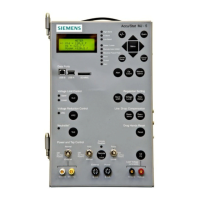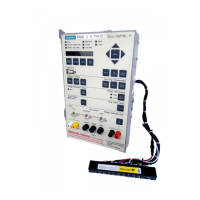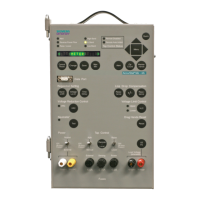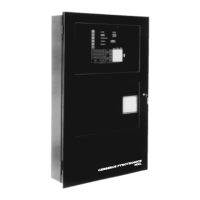4 Setting Up the MJ-4A & MJ-4B Control Panel
Siemens Energy, Inc. 25
Date
The Date data item allows you to set the real-time calen-
dar. Use the format selected in the Format item. If the for-
mat defined below is MO/DA/YR, enter the date as 09/30/
07.
Format
The Format item allows you to set the format for the Date.
Daylight Sav (Daylight Savings Time)
The Daylight Sav data item automatically adjusts the clock
for the time changes on the second Sunday in March and
lfirst Sunday in November.
4.3.23 Demand Methods
Demand values are system parameters that have been
averaged over a user-defined time period. Demand values
are accumulated separately for both forward and reverse
power flow conditions. Demand values can be viewed in
the Forward and Reverse <DEMAND> Menus. (See
Chapter 5.)
The MJ-4
Control Panel accumulates demand values for
Load Voltage, Source Voltage, Compensated Voltage,
Load Current, kW, kVAR, and kVA. In addition, Power Fac-
tor is stored whenever a new kVA maximum or minimum
is recognized.
Demand calculations are reset at the following times:
• system power up.
• when demand configuration items are changed.
• when power flow direction changes.
When a demand value is reset, dashes ‘-’ appear on the
display screen until completion of the first demand period.
The MJ-4
Control Panel provides two methods of comput-
ing demand: the Sliding Window method and the Thermal
averaging method.
Sliding Window Method
The Sliding Window (or rolling interval) method divides the
time interval into subperiods. Meter values are individually
recorded once each second. At the end of each subperiod
an average value is derived for each Meter value; the val-
ues for the oldest subperiod are discarded and new
demand values are calculated.
The DmdTime parameter specifies the number of min-
utes in the period; the DmdSubperiods parameter speci-
fies the number of subperiods in the demand period. For
example, a DmdTime of 30 minutes and a DmdSubperiod
of 6 subperiods defines a thirty minute sliding window
that moves every five minutes.
To use the Sliding Window method, view Dmd Type and
specify WINDOW. Then view DmdTime and specify the
length of the period in minutes (1 to 999); view DmdSub-
periods and specify the number of subperiods as a num-
ber between 1 and 99.
Thermal Method
The Thermal method is typical of the characteristic time
lag of mechanical or thermal devices as they absorb elec-
trical energy. It is based on the Code for Electricity Meters,
ANSI C12-1975, which defines the interval of a thermal
demand meter as the time required for the meter to indi-
cate 90% of a change in the load. Demand values are
updated once each second.
For example, if you specify DmdTime = 15, the demand
meter indicates 90% of a steady load fifteen minutes after
the load is applied. In the next fifteen minutes, it responds
to 90% of the remainder of the total load. As a result, the
load is constantly averaged and transient variations are not
reflected.
Note: The Demand Subperiod data item is ignored by
the Thermal method.
4.3.24 Min/Max t.o. (Min/Max Time Out)
The Min/Max t.o. data item defines the length of time that
the Min/Max data items will be presented at the display
screen. At the end of this period, the display returns to the
present value.
To specify the Min/Max timeout period, view Min/Max
t.o.; use the Change key and the Scroll keys to define the
number of seconds in the time-out period. Then press the
Save key to complete the change process.
4.3.25 Screen t.o. (Screen Time Out)
The Screen t.o. data item defines the length of time that
any data item is displayed. At the end of the timeout
period, the display returns to the default display defined
by the DspScr data item.
4.3.26 Quick t.o. (Quick Time Out)
The Quick t.o. data item defines the length of time that
the Quick List data items will be presented at the display
screen. At the end of this period, the display returns to the
previous screen. See section 4.9.
4.3.27 QuickDispTim (Quick Display Time)
The QuickDispTim data item defines the length of time
that each data item in the Quick List will be displayed
before moving to the next item when the Quick List is in
its slide show mode. See section 4.9.
4.3.28 Auto Variamp
The Auto Variamp data item enables a capability that auto-
matically reduces the tap position based on the average
load current over the last 10 minutes compared to the I
Full Load. For example, if the regulator is at 105% of its
rated current on average for the last 10 minutes, the regu-
lator will not be permitted to move past 14 raise or lower
and it will move to 14 raise or lower if it is on a higher tap.
If the regulator is at 140% of its rated current on average

